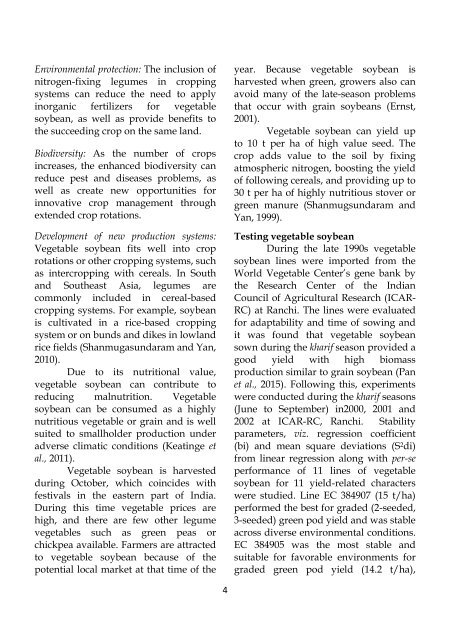SOYBEAN RESEARCH
Soybean-Research-14(2)-2016
Soybean-Research-14(2)-2016
You also want an ePaper? Increase the reach of your titles
YUMPU automatically turns print PDFs into web optimized ePapers that Google loves.
Environmental protection: The inclusion of<br />
nitrogen-fixing legumes in cropping<br />
systems can reduce the need to apply<br />
inorganic fertilizers for vegetable<br />
soybean, as well as provide benefits to<br />
the succeeding crop on the same land.<br />
Biodiversity: As the number of crops<br />
increases, the enhanced biodiversity can<br />
reduce pest and diseases problems, as<br />
well as create new opportunities for<br />
innovative crop management through<br />
extended crop rotations.<br />
Development of new production systems:<br />
Vegetable soybean fits well into crop<br />
rotations or other cropping systems, such<br />
as intercropping with cereals. In South<br />
and Southeast Asia, legumes are<br />
commonly included in cereal-based<br />
cropping systems. For example, soybean<br />
is cultivated in a rice-based cropping<br />
system or on bunds and dikes in lowland<br />
rice fields (Shanmugasundaram and Yan,<br />
2010).<br />
Due to its nutritional value,<br />
vegetable soybean can contribute to<br />
reducing malnutrition. Vegetable<br />
soybean can be consumed as a highly<br />
nutritious vegetable or grain and is well<br />
suited to smallholder production under<br />
adverse climatic conditions (Keatinge et<br />
al., 2011).<br />
Vegetable soybean is harvested<br />
during October, which coincides with<br />
festivals in the eastern part of India.<br />
During this time vegetable prices are<br />
high, and there are few other legume<br />
vegetables such as green peas or<br />
chickpea available. Farmers are attracted<br />
to vegetable soybean because of the<br />
potential local market at that time of the<br />
year. Because vegetable soybean is<br />
harvested when green, growers also can<br />
avoid many of the late-season problems<br />
that occur with grain soybeans (Ernst,<br />
2001).<br />
Vegetable soybean can yield up<br />
to 10 t per ha of high value seed. The<br />
crop adds value to the soil by fixing<br />
atmospheric nitrogen, boosting the yield<br />
of following cereals, and providing up to<br />
30 t per ha of highly nutritious stover or<br />
green manure (Shanmugsundaram and<br />
Yan, 1999).<br />
Testing vegetable soybean<br />
During the late 1990s vegetable<br />
soybean lines were imported from the<br />
World Vegetable Center‘s gene bank by<br />
the Research Center of the Indian<br />
Council of Agricultural Research (ICAR-<br />
RC) at Ranchi. The lines were evaluated<br />
for adaptability and time of sowing and<br />
it was found that vegetable soybean<br />
sown during the kharif season provided a<br />
good yield with high biomass<br />
production similar to grain soybean (Pan<br />
et al., 2015). Following this, experiments<br />
were conducted during the kharif seasons<br />
(June to September) in2000, 2001 and<br />
2002 at ICAR-RC, Ranchi. Stability<br />
parameters, viz. regression coefficient<br />
(bi) and mean square deviations (S 2 di)<br />
from linear regression along with per-se<br />
performance of 11 lines of vegetable<br />
soybean for 11 yield-related characters<br />
were studied. Line EC 384907 (15 t/ha)<br />
performed the best for graded (2-seeded,<br />
3-seeded) green pod yield and was stable<br />
across diverse environmental conditions.<br />
EC 384905 was the most stable and<br />
suitable for favorable environments for<br />
graded green pod yield (14.2 t/ha),<br />
4


